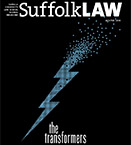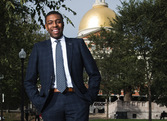
From “Locker Room Lawyer” to SJC
The transformation of Justice Frank M. Gaziano
By Stephanie Schorow
As might be expected, the spacious office of Frank M. Gaziano JD ’89, associate justice of the Supreme Judicial Court of Massachusetts, is lined with neat rows of legal volumes that stretch from floor to ceiling. But what really arrests your attention is the large poster of a husky, shaggy-haired Frank when he was a linebacker for Lafayette College. Looking like a ’70s rocker, he seems to regard the world with devil-may-care insouciance. Gaziano admitted during his comments at the Suffolk University Law Review’s 50th anniversary that his grooming during that time included a luxuriant moustache that made him look like a henchman on the 1980s cop show Miami Vice.
That poster strikes a broad contrast to today’s bespectacled, clean-shaven, and soft-spoken judge. Which is precisely why his friends had it made up for his Supreme Court swearing-in ceremony. Massachusetts Governor Charlie Baker, who appointed Gaziano, got such a kick out of the poster he took a selfie with it.
Why keep such an offbeat image in a place of honor within the austere Adams Courthouse? To understand that is to grasp Gaziano’s wry, very human outlook on life.
The first Suffolk Law graduate to reach a seat on Massachusetts’s highest court also joked to the crowd at the Clinical Programs 50th anniversary that he remains “an incredible disappointment” to his mother, an immigrant from Sicily—because he “could have been successful” if he had chosen to stay in private practice. He is the kind of legal expert who pokes fun at his days at the Law Review by declaring to an audience of review alums that it was finally time for Suffolk to acknowledge the “groundbreaking impact” of his 1987 Law Review comment on “Rhode Island non-conforming use zoning.”
When Gaziano became a trial judge, he joked: “If I didn’t play football in college, I’d be on the SJC.” Now he can’t make that joke anymore. Playing football ensured that Gaziano, who grew up in Quincy, Massachusetts, as the child of first-generation Italian immigrants, could get a college education. At Lafayette, a coach once accused him of being a “locker room lawyer,” probably because he knew how to hold his ground in an argument. “Law was something that was completely foreign to me and my family, so that’s why it was somewhat interesting that I got into this field,” he said.
Another sketch on the judge’s office walls shows him passionately giving a closing argument in federal court. When Gaziano entered Suffolk Law, he thought he might concentrate on real estate or construction law. But a criminal law course with James “Jamie” Sulton fired his imagination. He also was impressed by how Professor Jeffrey Wittenberg took a dry subject like the Uniform Commercial Code and made it come to life. And Gaziano’s participation in Suffolk’s Clinical Programs as a student prosecutor was transformative; he developed a passion and talent for courtroom advocacy.
After graduating magna cum laude, he began his legal career at the Boston law firm of Foley Hoag as a litigation associate. In 1991, he became an assistant district attorney with the Plymouth County District Attorney’s Office in Brockton, despite the pleading of his mother, who told him, “I can’t believe you’re throwing your diploma away to work for the government.” He was appointed to the state’s Superior Court in 2004 and the Supreme Judicial Court in 2016.
His days pondering Rhode Island non-conforming use zoning are long past. Today, for example, Justice Gaziano has been tasked with determining if a search for cell phone data in a drug case exceeded the permissible scope of a warrant (Commonwealth v. Perkins). And in November, the high court heard arguments on whether a family could sue MIT for wrongful death over the suicide of their son, an MIT student. Gaziano’s question to the MIT lawyer (over whether a resident adviser could be responsible for stopping a student who is threatening to kill himself) was scrutinized by court watchers.
While he cannot discuss specific cases nor even comment with any depth on broad issues, Gaziano is forthright about the benefits of televising legal proceedings. “I’m a big proponent of cameras in the courtroom,” he says. “The public paid for the courtroom, so they have a right to know what’s going on in public buildings. … The fact that they don’t televise Supreme Court arguments, I think, is a shame.” He adds, “Who wouldn’t want to watch Bush vs. Gore? Who wouldn’t want to watch any other case? They should be on C-SPAN.”
He’s very happy that Supreme Court proceedings are archived by the Law School so students can watch the arguments. Gaziano ponders: “What you say shapes the law, and it’s what the next generation of law students is going to learn on common law. And you have a responsibility, obviously, to get it right.”
And, as he notes with typical humor, he still has 16 years until mandatory retirement to slip a reference to his article on “Rhode Island non-conforming use zoning” into an Supreme Court opinion.





